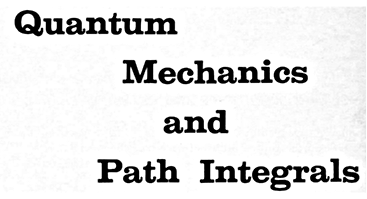
\(\)
Problem 8-1
Note that the amplide to go from any state \(f(x)\) to another state \(g(x)\) is the transition
amplitude \(\langle g | 1 | f\rangle\) as defined in Eq. (7-1).
Suppose \(f(x)\) and \(g(x)\) are expanded in terms of the orthogonal function \(\phi_n(x)\), the solutions to the wave equation associated with the kernel \(K(2,1)\), as discussed in Sec. 4-2. Thus
\def\ppdiff#1#2{\frac{\partial #1}{\partial #2}}
\def\pdiff#1{\frac{\partial}{\partial #1}}
\def\bra#1{\langle #1 |}
\def\ket#1{| #1 \rangle}
\def\BK#1#2{\langle #1 | #2 \rangle}
\def\BraKet#1#2#3{\langle #1 | #2 | #3 \rangle}
\def\reverse#1{\frac{1}{#1}}
f(x)=\sum_n f_n\phi_n(x),\quad g(x)=\sum_ng_n\phi_n(x)
\tag{8-23}
\end{equation}
Using the coefficients \(f_n\) and \(g_n\) and Eq. (4-59), show that the transition amplitude can be witten as
\iint g^{*}(x_2)\,K(x_2,T; x_1,0)\,f(x_1)\,dx_1\,dx_2
= \sum_n g^{*}_n f_n\,e^{-iE_nT/\hbar}
\tag{8-24}
\end{equation}
Next, suppose we choose a special pair of functions \(f(x)\) and \(g(x)\) for which the expansion on the right-hand side of Eq. (8-24) is simple. Then after obtaining the functions \(f_n\) we could get some information about the wave functions \(\phi_n(x)\) from the expansions of Eq. (8-23). Suppose we choose the functions \(f(x)\) and \(g(x)\) in the following way
f(x)&=\left(\frac{m\omega}{\pi\hbar}\right)^{1/4} \exp\left[-\frac{m\omega}{2\hbar}(x-a)^{2}\right]
\tag{8-25}\\
g(x)&=\left(\frac{m\omega}{\pi\hbar}\right)^{1/4} \exp\left[-\frac{m\omega}{2\hbar}(x-b)^{2}\right]
\tag{8-26}
\end{align}
These functions represent gaussian distributions centered about \(a\) and \(b\), respectively.
We shall call \(f_n=f_n(a)\) and \(g_n=f_n(b)\). Determine the transition amplitude \(\BraKet{g}{1}{f}\), where \(f(x)\) and \(g(x)\) are given by Eqs. (8-25) and (8-26), respectively, and the kernel is that for a harmonic oscillator, Eq. (8-1). Perform the integrals in Eq. (8-24) to get
\exp\left\{-\frac{i\omega T}{2}-\frac{m\omega}{4\hbar}\Big(a^{2}+b^{2}-2ab\,e^{-i\omega T}\Big)\right\}
=\sum_n g^{*}_n(b)f_n(a)\,e^{-iE_nT/\hbar}
\tag{8-27}
\end{equation}
From this result show that \(\displaystyle{E_n=\hbar\omega\left(n+\frac{1}{2}\right)}\) and that
f_n(a)=\left(\frac{m\omega}{2\hbar}\right)^{n/2} \frac{a^{n}}{\sqrt{n!}}
\exp\left(-\frac{m\omega a^{2}}{4\hbar}\right)
\tag{8-28}
\end{equation}
Using this result in Eq. (8-23) and write for \(f_n(x)\) the form given by Eq. (8-7) considering the \(H_n(x)\) still unknown. From this derive the generating function of Eq. (8-9) for these functions \(H_n(x)\).
( 解答 ) 【 a 】 遷移要素 \(\BraKet{g}{1}{f}\) に式 (8-10): \(K(2,1)=\sum \phi_l(x_2)\phi^{*}_l(x_1)e^{-iE_lT/\hbar}\) と式 (8-23) を代入し, 関数 \(\phi_n(x)\) の規格直交性を用いるならば,
\begin{align*}
\BraKet{g}{1}{f}&=\iint dx_2\,dx_1\,g^{*}(x_2)\,K(2,1)\,f(x_1)\\
&=\iint dx_2\,dx_1\sum_n g_n^{*}\phi_n^{*}(x_2)\,K(2,1)\sum_m f_m\,\phi_m(x_1)\\
&=\int dx_2\sum_n g_n^{*}\phi_n^{*}(x_2)\sum_m f_m \int dx_1\sum_l\phi_l(x_2)\phi_l^{*}(x_1)e^{-iE_lT/\hbar}
\phi_m(x_1)\\
&=\int dx_2\sum_n g_n^{*}\phi_n^{*}(x_2)\sum_m f_m \sum_l\phi_l(x_2)e^{-iE_lT/\hbar}\int dx_1\,\phi_l^{*}(x_1)
\phi_m(x_1)\\
&=\int dx_2\sum_n g_n^{*}\phi_n^{*}(x_2)\sum_m f_m \sum_l\phi_l(x_2)e^{-iE_lT/\hbar}\,\delta_{l\,m}\\
&=\int dx_2\sum_n g_n^{*}\phi_n^{*}(x_2)\sum_m f_m\phi_m(x_2)e^{-iE_mT/\hbar}\\
&=\sum_n g_n^{*}\sum_m f_m\,e^{-iE_mT/\hbar}\int dx_2\,\phi_n^{*}(x_2)\,\phi_m(x_2)\\
&=\sum_n g_n^{*}\sum_m f_m\,e^{-iE_mT/\hbar}\,\delta_{n\,m}
=\sum_n g_n^{*}\,f_n\,e^{-iE_nT/\hbar}
\end{align*}
よって,
\BraKet{g}{1}{f}=\iint dx_2\,dx_1\,g^{*}(x_2)\,K(2,1)\,f(x_1)=\sum_n g_n^{*}\,f_n\,e^{-iE_nT/\hbar}
\tag{1}
\end{equation}
【 b 】 遷移要素 \(\BraKet{g}{1}{f}\) に核の式 (8-1), 及び \(f\) と \(g\) の式 (8-25), 式 (8-26) を代入すると,
&\BraKet{g}{1}{f}=\iint dx_2\,dx_1\,g^{*}(x_2)\,K(2,1)\,f(x_1)\notag\\
&\quad=\iint dx_2\,dx_1\,\left(\frac{m\omega}{\pi\hbar}\right)^{1/2}\exp\left\{-\frac{m\omega}{2\hbar}
\Bigl[(x_2-b)^{2}+(x_1-a)^{2}\Bigr]\right\}\left(\frac{m\omega}{2\pi i\hbar\sin \omega T}\right)^{1/2}\notag\\
&\qquad\times\exp\left\{\frac{im\omega}{2\hbar\sin\omega T}\Bigl[(x_1^{2}+x_2^{2})\cos\omega T – 2x_1x_2
\Bigr]\right\}
\tag{2}
\end{align}
まず D.F.Styer の解答を参照して, 変数を次のような無次元量に変換する:
\alpha\equiv \left(\frac{m\omega}{2\hbar}\right)^{1/2},&\quad
\bar{x}_1=\alpha x_1 \quad \bar{x}_2=\alpha x_2,\quad \bar{a}=\alpha a,\quad \bar{b}=\alpha b\notag\\
&\Rightarrow\ x_1=\frac{\bar{x}_1}{\alpha},\quad x_2=\frac{\bar{x}_2}{\alpha},\quad
a=\frac{\bar{a}}{\alpha},\quad b=\frac{\bar{b}}{\alpha}
\tag{3}
\end{align}
すると式 (2) は次となる:
&\left(\frac{2}{\pi}\right)^{1/2}\alpha\iint \frac{d\bar{x}_2}{\alpha}
\frac{d\bar{x}_1}{\alpha}\exp\left\{-\alpha^{2}\left[\reverse{\alpha^{2}}(\bar{x}_2-\bar{b})^{2}
+\reverse{\alpha^{2}}(\bar{x}_1-\bar{a})^{2}\right]\right\}\alpha\left(\reverse{\pi i\sin\omega T}\right)^{1/2}\notag\\
&\qquad\times\exp\left\{\frac{i\alpha^{2}}{\sin\omega T}\left[\reverse{\alpha^{2}}(\bar{x}_1^{2}
+\bar{x}_2^{2})\cos\omega T -\frac{2}{\alpha^{2}}\bar{x}_1\bar{x}_2\right]\right\}\notag\\
&=\left(\frac{2}{\pi^{2} i\sin \omega T}\right)^{1/2}\iint d\bar{x}_2d\bar{x}_1\,\exp\left\{-(\bar{x}_2
-\bar{b})^{2}-(\bar{x}_1-\bar{a})^{2}+\frac{i\cos\omega T}{\sin\omega T}(\bar{x}_1^{2}+\bar{x}_2^{2})
-\frac{2i}{\sin\omega T}\bar{x}_2\bar{x}_1\right\}\notag\\
&=\left(\frac{2}{\pi^{2} i\sin \omega T}\right)^{1/2}\exp\left\{-(\bar{a}^{2}+\bar{b}^{2})\right\}\notag\\
&\qquad\times\iint d\bar{x}_2d\bar{x}_1\,
\exp\left\{\left(-1+i\frac{\cos\omega T}{\sin\omega T}\right)(\bar{x}_1^{2}+\bar{x}_2^{2})+2(\bar{a}
\bar{x}_1+\bar{b}\bar{x}_2)-\frac{2i}{\sin\omega T}\bar{x}_1\bar{x}_2\right\}\notag\\
&=\left(\frac{2}{\pi^{2} i\sin \omega T}\right)^{1/2}\exp\left\{-(\bar{a}^{2}+\bar{b}^{2})\right\}\notag\\
&\qquad\times\iint d\bar{x}_2d\bar{x}_1\,\exp\left\{\reverse{\sin\omega T}\left[ie^{i\omega T}(\bar{x}_1^{2}+
\bar{x}_2^{2})+2(\bar{a}\bar{x}_1+\bar{b}\bar{x}_2)\sin\omega T-2i\bar{x}_1\bar{x}_2\right]\right\}
\tag{4}
\end{align}
積分を簡単に実行するために, 座標軸を \(\pi/4\) 回転して新しい変数 \(x’_1,\,x’_2\) に変更する.これは単なる座標回転であるから, 積分範囲に変更はないし余計な因子も発生しない:
\bar{x}_1=\reverse{\sqrt{2}}(x’_1-x’_2),\quad \bar{x}_2=\reverse{\sqrt{2}}(x’_1+x’_2).
\tag{5}
\end{equation}
すると, 式 (4) の積分部分は分離した2つの積分となる:
&\iint dx’_1dx’_2\,\exp\left\{\reverse{\sin\omega T}\left[ie^{i\omega T}(x’^{2}_1+x’^{2}_2)
+\sqrt{2}(\bar{a}x’_1-\bar{a}x’_2+\bar{b}x’_1+\bar{b}x’_2)\sin\omega T-i(x’^{2}_1-x’^{2}_2)\right]\right\}\notag\\
&=\int dx’_1\,\reverse{\sin\omega T}\left[e(e^{i\omega T}-1)x’^{2}_1+\sqrt{2}(\bar{a}+\bar{b})x’_1\sin\omega T\right]\notag\\
&\qquad\times\int dx’_2\reverse{\sin\omega T}\left[i(e^{i\omega T}+1)x’^{2}_2+\sqrt{2}(-\bar{a}+\bar{b})x’^{2}_2\sin\omega T\right]
\tag{6}
\end{align}
各々の積分は,Feynman-Hibbsの付録「役に立つ定積分」にある公式
\int_{-\infty}^{\infty}e^{ax^{2}+bx}\,dx=\sqrt{\frac{\pi}{-a}}\exp\left(-\frac{b^{2}}{4a}\right)
\tag{7}
\end{equation}
を当てはめて実行出来る.また, 式 (8-11) から
\frac{2i\sin\omega T}{e^{2i\omega T}-1}=\frac{e^{i\omega T}(1-e^{-2i\omega T})}{e^{2i\omega T}(1-e^{-2i\omega T})}=e^{-i\omega T}
\tag{8}
\end{equation}
も利用する.すると式 (4) すなわち式 (2) は結局次となる:
&\left(\frac{2}{\pi^{2} i\sin \omega T}\right)^{1/2}\exp\left\{-(\bar{a}^{2}+\bar{b}^{2})\right\}
\frac{\pi\sin\omega T}{i(1-e^{i\omega T})}\exp\left\{\frac{(\bar{a}+\bar{b})^{2}\sin\omega T}{i(1-e^{i\omega T})}\right\}\notag\\
&\qquad\times\left(\frac{\pi\sin\omega T}{-i(1+e^{i\omega T})}\right)^{1/2}
\exp\left\{-\frac{(a-b)^{2}\sin\omega T}{i(1+e^{i\omega T})}\right\}\notag\\
&=\left(\frac{2}{\pi^{2} i\sin \omega T}\right)^{1/2}\exp\left\{-(\bar{a}^{2}+\bar{b}^{2})\right\}
\frac{\pi\sin\omega T}{(1-e^{2i\omega T})^{1/2}}\exp\left\{i\sin\omega T\left[\frac{(\bar{a}^{2}+\bar{b}^{2})
e^{i\omega T}+2\bar{a}\bar{b}}{e^{2i\omega T}-1}\right]\right\}\notag\\
&=\left(\frac{2i\sin\omega T}{e^{2i\omega T}-1}\right)^{1/2}\exp\left\{-(\bar{a}^{2}+\bar{b}^{2})\right\}
\exp\left\{\frac{i\sin\omega T}{e^{2i\omega T}-1}\bigl[(\bar{a}^{2}+\bar{b}^{2})e^{i\omega T}+2\bar{a}\bar{b}\bigr]\right\}\notag\\
&=\exp\left\{-i\frac{\omega T}{2}\right\}\exp\left\{-(\bar{a}^{2}+\bar{b}^{2})\right\}\exp\left\{
\frac{e^{-i\omega T}}{2}\bigl[(\bar{a}^{2}+\bar{b}^{2})e^{i\omega T}+2\bar{a}\bar{b}\bigr]\right\}\notag\\
&=\exp\left\{-\frac{i\omega T}{2}-\frac{m\omega}{4\hbar}\left(a^{2}+b^{2}-2ab\,e^{-i\omega T}\right)\right\}
\tag{9}
\end{align}
よって式 (8-24) は次となる:
\BraKet{g}{1}{f}=\exp\left\{-\frac{i\omega T}{2}-\frac{m\omega}{4\hbar}\left(a^{2}+b^{2}-2ab\,
e^{-i\omega T}\right)\right\}=\sum_n g^{*}_n(b)f_n(a)\,e^{-iE_nT/\hbar}
\tag{10}
\end{equation}
この問題に一致する議論が Schiff の § 13 (p.87) で為されている.そこの結果をここの問題に合わせて表わすならば,
\psi(x_2,T)&=\int_{-\infty}^{\infty}dx_1\,K(x_2,T; x_1,t_0)\,f(x_1,t_0)\notag\\
&=\left(\frac{m\omega}{\pi\hbar}\right)^{1/4}\exp\left\{-\alpha^{2}x_2^{2}-\reverse{2}\alpha^{2}a^{2}
-\frac{i\omega T}{2}-\reverse{2}\alpha^{2}a^{2}e^{-2i\omega T}+2\alpha^{2}xa\,e^{-i\omega T}\right\}
\tag{11}
\end{align}
これを用いると, 式 (2) は次のように表される:
\BraKet{g}{1}{f}&=\int dx_2\,g^{*}(x_2)\int dx_1\,K(2,1)\,f(x_1)=\int dx_2 g^{*}(x_2)\psi(x_2,T)\notag\\
&=\left(\frac{m\omega}{\pi\hbar}\right)^{1/2}\int dx_2\,\exp\left\{-\alpha^{2}(x_2-b)^{2}\right\}\notag\\
&\quad\times\exp\left\{-\alpha^{2}x_2^{2}-\reverse{2}\alpha^{2}a^{2}-\frac{i\omega T}{2}-\reverse{2}
\alpha^{2}a^{2}e^{-2i\omega T}+2\alpha^{2}xa\,e^{-i\omega T}\right\}\notag\\
&=\left(\frac{m\omega}{\pi\hbar}\right)^{1/2}\exp\left\{-\reverse{2}\alpha^{2}a^{2}
-\frac{i\omega T}{2}-\reverse{2}\alpha^{2}a^{2}e^{-2i\omega T}\right\}\notag\\
&\quad\times\int dx_2\,\exp\left\{-\alpha^{2}(x_2-b)^{2}\right\}\exp\left\{-\alpha^{2}x_2^{2}+2\alpha^{2}a\,
e^{-i\omega T}x_2\right\}
\tag{12}
\end{align}
この積分部分を feynman&Hibbs 付録の公式
\int_{-\infty}^{\infty}e^{a(x-x_1)^{2}}e^{b(x-x_2)^{2}}\,dx=\sqrt{\frac{-\pi}{a+b}}\,\exp\left[\frac{ab}{a+b}
(x_1-x_2)^{2}\right]
\tag{13}
\end{equation}
を利用して実行するならば, やはり式 (9) と同じ結果となることが分かる.
【 c 】 \(f_n(a)\) と \(g_n(b)\) を式 (8-28) の形であるとして, 式 (8-27) の右辺に代入すると
\sum_n f_n(a)g^{*}_n(b)e^{-iE_nT/\hbar}
&=\sum_n \left(\frac{m\omega}{2\hbar}\right)^{n/2}\frac{a^{n}}{\sqrt{n!}}\,
\exp\left(-\frac{m\omega a^{2}}{4\hbar}\right)\cdot
\left(\frac{m\omega}{2\hbar}\right)^{n/2}\frac{b^{n}}{\sqrt{n!}}\,
\exp\left(-\frac{m\omega b^{2}}{4\hbar}\right)\exp\left(-\frac{iE_nT}{\hbar}\right)\notag\\
&=\exp\left\{-\frac{m\omega}{4\hbar}\Big(a^{2}+b^{2}\Big)\right\}
\sum_n \left(\frac{m\omega}{2\hbar}\right)^{n}\frac{a^{n}b^{n}}{n!}\exp\left(-\frac{iE_nT}{\hbar}\right)
\tag{14}
\end{align}
そこで式 (8-27) の左辺を次のように書いてみる:
\exp\left[-\frac{i\omega T}{2}-\frac{m\omega}{4\hbar}(a^{2}+b^{2}-2ab\,e^{-i\omega T})\right]
&=\exp\left\{-\frac{m\omega}{4\hbar}\Big(a^{2}+b^{2}\Big)\right\}
\exp\left[-\frac{i\omega T}{2}+\frac{m\omega}{2\hbar}ab\,e^{-i\omega T}\right]
\tag{15}
\end{align}
以上の式 (14) と式 (15) を比較して, 次であれば良いことが分かる:
\sum_n \left(\frac{m\omega}{2\hbar}\right)^{n}\frac{a^{n}b^{n}}{n!}\exp\left(-\frac{iE_nT}{\hbar}\right)
=\exp\left[-\frac{i\omega T}{2}+\frac{m\omega}{2\hbar}ab\,e^{-i\omega T}\right]
\tag{16}
\end{equation}
そこで \(\displaystyle{E_n=\hbar\omega\left(n+\frac{1}{2}\right)}\) と仮定して, これを上式の左辺に代入して見ると, \(e^{x}\) のテイラー展開公式: \(\displaystyle{e^{x}=\sum_{n=0}^{\infty} \frac{1}{n!}x^{n}}\) を利用することで式 (16) の右辺に一致することが分かる:
\sum_n \left(\frac{m\omega}{2\hbar}\right)^{n}\frac{a^{n}b^{n}}{n!}\exp\left(-\frac{iE_nT}{\hbar}\right)
&=\sum_n \left(\frac{m\omega}{2\hbar}\right)^{n}\frac{a^{n}b^{n}}{n!}
\exp\left\{-i\omega T\left(n+\frac{1}{2}\right)\right\}\notag\\
&=\exp\left\{-\frac{i\omega T}{2}\right\}
\sum_n \left(\frac{m\omega}{2\hbar}\right)^{n}\frac{a^{n}b^{n}}{n!}\,e^{-i\omega Tn}\notag\\
&=\exp\left\{-\frac{i\omega T}{2}\right\} \sum_n \frac{1}{n!}
\left(\frac{m\omega}{2\hbar}ab\,e^{-i\omega T}\right)^{n}\notag\\
&=\exp\left\{-\frac{i\omega T}{2}\right\}\times\exp\left(\frac{m\omega}{2\hbar}ab\,e^{-i\omega T}\right)\notag\\
&=\exp\left[-\frac{i\omega T}{2}+\frac{m\omega}{2\hbar}ab\,e^{-i\omega T}\right]
\end{align}
よって \(f_n\) が式 (8-28) の形であるならば, \(E_n\) は \(\displaystyle{E_n=\hbar\omega\left(n+\frac{1}{2}\right)}\) で良いことが示された.
【 d 】 \(\phi_n(x)\) として式 (8-7) を仮定し, 式 (8-25) と式 (8-28) を式 (8-23) に代入してみる. ただし簡単化のために変数を次のように置き換える:
\beta =\sqrt{\frac{m\omega}{\hbar}},
\tag{17}
\end{equation}
すると, 式 (8-25) と式 (8-28) および式 (8-7) は次に書ける:
f(x)&=\left(\frac{\beta}{\sqrt{\pi}}\right)^{1/2}\exp\left\{-\frac{\beta^{2}}{2}(x-a)^{2}\right\}
\tag{18}\\
f_n&=\frac{\beta^{n}}{\sqrt{2^{n}}}\frac{a^{n}}{\sqrt{n!}}\exp\left(-\frac{\beta^{2}}{4}a^{2}\right)
\tag{19}\\
\phi_n(x)&=\left(\frac{\beta}{\sqrt{\pi}}\right)^{1/2}\!\frac{1}{\sqrt{2^{n}n!}}\,H_n(\beta x)\,
\exp\left(-\frac{\beta^{2}}{2}x^{2}\right)
\tag{20}
\end{align}
これらを式 (8-23): \(f(x)=\sum_n f_n\phi_n(x)\) に代入すると,
&\left(\frac{\beta}{\sqrt{\pi}}\right)^{1/2}\exp\left\{-\frac{\beta^{2}}{2}(x-a)^{2}\right\}
=\sum_n \frac{\beta^{n}}{\sqrt{2^{n}}}\frac{a^{n}}{\sqrt{n!}}\exp\left(-\frac{\beta^{2}}{4}a^{2}\right)
\times \left(\frac{\beta}{\sqrt{\pi}}\right)^{1/2}\!\frac{1}{\sqrt{2^{n}n!}}\,H_n(\beta x)\,
\exp\left(-\frac{\beta^{2}}{2}x^{2}\right),\notag\\
&\exp\left\{-\frac{\beta^{2}}{2}x^{2}+\beta^{2}ax-\frac{\beta^{2}}{2}a^{2}\right\}
=\sum_n \frac{\beta^{n}a^{n}}{2^{n}n!}\exp\left(-\frac{\beta^{2}}{4}a^{2}\right)\,
\exp\left(-\frac{\beta^{2}}{2}x^{2}\right)\,H_n(\beta x),\notag\\
&\exp\left(-\frac{\beta^{2}}{2}x^{2}\right)\exp\left(\beta^{2}ax\right)
\exp\left(-\frac{\beta^{2}}{2}a^{2}\right)=\exp\left(-\frac{\beta^{2}}{4}a^{2}\right)\,
\exp\left(-\frac{\beta^{2}}{2}x^{2}\right)\sum_n \frac{\beta^{n}a^{n}}{2^{n}n!}\,H_n(\beta x),\notag\\
&\exp\left(\beta^{2}ax-\frac{\beta^{2}}{4}a^{2}\right)
=\sum_n H_n(\beta x)\frac{1}{n!}\left(\frac{\beta}{2}a\right)^{n},\notag\\
&\Rightarrow\quad
\exp\left\{-\left(\frac{\beta}{2}a\right)^{2}+2\left(\frac{\beta}{2}a\right)\beta x \right\}
=\sum_n H_n(\beta x)\frac{1}{n!}\left(\frac{\beta}{2}a\right)^{n}
\tag{21}
\end{align}
そこで, 次のような置き換えをする:
t=\frac{\beta}{2}a,\qquad y=\beta x
\tag{22}
\end{equation}
すると, 上式は次のように書き直すことが出来る:
\exp\big(-t^{2}+2tx\big)=\sum_n H_n(y)\frac{t^{n}}{n!}
\end{equation}
これはまさに関数 \(H_n(x)\) に対する母関数についての式 (8-9) である.

